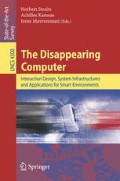Abstract
In academia and in industry there have been many projects focusing on technology in domestic spaces and the Smart home (Hindus 2001; Smith 2000). The focus has been on the place, i.e. the home, and the people living there, rather than the people and the places they inhabit. In this chapter we share experience from using cooperative and novel design methods developed within the project interLiving – Designing Interactive, Intergenerational Interfaces for Living Together. The methods were intended to involve families, both as groups and individuals of all ages, as well as the multidisciplinary research group, in co-design of communication devices for families. We highlight methods, results and impact for future research and development. Research presented here aimed to develop novel and appreciated communication artefacts and to improve design methods within participatory design.
Access this chapter
Tax calculation will be finalised at checkout
Purchases are for personal use only
Preview
Unable to display preview. Download preview PDF.
References
Blomberg, J.L., Henderson, A.: Reflections on participatory design: Lessons from the Trillium experience. In: Proceedings of ACM CHI 90 Conference on Human Factors in Computing Systems, pp. 353–359. ACM Press, New York (1990)
Bødker, S., Ehn, P., Sjögren, D., Sundblad, Y.: Co-operative Design - perspectives on 20 years with “the Scandinavian IT Design Model”. In: Proceedings of NordiCHI 2000, pp. 1–10 (2000)
Cooper, D.E.: Meaning. Acumen Publishing, Chesham (2003)
Crabtree, A., Rodden, T.: Technology and the Home: Supporting Cooperative Analysis of the Design Space. Position Paper for CHI 2002 New Technologies for Families Workshop (2002), http://www.cs.umd.edu/hcil/interliving/chi02/crabtree.htm
Crabtree, A.: Designing Collaborative systems. A Practical Guide to Ethnography. Springer, London (2003)
Csikszentmihalyi, M., Rochberg-Halton, E.: The meaning of things. Domestic symbols and the self. Cambridge University Press, Cambridge (1981)
Davis, R., Talbot, R.J.: Experiencing ideas. Design Studies 8(1), 17–25 (1987)
Equator Interdisciplinary Research Collaboration, http://www.equator.ac.uk/
Gaver, W., Dunne, A., Pacenti, E.: Projected Realities: Conceptual Design for Cultural Effect. In: Proceedings ACM Human Factors in Computing Systems (CHI ’99), pp. 600–608. ACM Press, New York (1999)
Gedenryd, H.: How Designers Work. Making Sense of Authentic Cognitive Activities. Lund University Cognitive Studies, vol. 75. Lund University, Lund (1998)
Gibson, J.: Reasons for realism. Lawrence Erlbaum Associates, Mahwah (1982)
Heskett, J.: Toothpicks and Logos: Design in Everyday Life. Oxford University Press, Oxford (2002)
Hindus, D., Mainwaring, S., Leduc, N., Hagström, A.E., Bayley, O.: Casablanca: designing social communication devices for the home. In: Proceedings of the SIGCHI conference on Human factors in computing, pp. 325–332. ACM Press, Seattle (2001)
Hutchinson, H., Mackay, W., Westerlund, B., Bederson, B., Druin, A., Plaisant, C., Beaudouin-Lafon, M., Conversy, S., Evans, H., Hansen, H., Roussel, N., Eiderbäck, B., Lindquist, S., Sundblad, Y.: Technology Probes: Inspiring Design for and with Families. In: Proceedings of ACM CHI 2003, Fort Lauderdale, Florida, pp. 17–24. ACM Press, New York (2003)
Interliving Project site, http://interliving.kth.se/
Istedt Hjelm S.: Making sense. Design for well-being. Stockholm, KTH, dissertation in Human-Computer Interaction, CID-250 (2004)
Krippendorff, K.: Redesigning Design; Invitation to a Responsible Future. In: Tahkokallio, P., Vihma, S. (eds.) Design - Pleasure or Responsibility? University of Art and Design, Helsinki, pp. 138–162 (1995)
Lantz, A., Räsänen, M., Forstorp, P.A.: Role expectations and relationships in cooperative design projects. TRITA-NA-P0507, IPLab-250. KTH, Stockholm (2005)
Loi D: A suitcase as a PhD? Exploring the potential of travelling containers to articulate the multiple facets of a research thesis. In: Working papers in art and design, vol. 3, the role of the artefact in art & design research. Research Into Practice Conference, Heartfield, London (2004)
Mackay, W.E., Fayard, A.-L.: HCI, Natural Science and Design: A Framework for Triangulation Across Disciplines. In: Proceedings of ACM DIS‘97, Designing Interactive Systems, Amsterdam, pp. 223–234. ACM Press, New York (1997)
Mackay, W.E., Ratzer, A.V., Janecek, P.: Video Artefacts for Design: bridging the gap between abstraction and detail. In: Proceedings of ACM DIS’00 (2000)
Mackay, W.E., Evans, H., Hansen, H., Dachary, L., Gaudron, N.: Weaving the Interactive Thread: An Interactive Event for the Tales of the disappearing computer, Santorini, June 2003, pp. 409–415 (2003)
Orlikowski, W.: The Duality of Technology: Rethinking the Concept of Technology in Organizations. Organization Science 3(3), 398–416 (1992)
Schön, D.: The Reflective Practitioner. MIT Press, Cambridge (1983)
Smith, T.: 3Com’s first Net appliance - Audrey, in the Register. Posted: 27/09/2000 (2000), http://www.theregister.co.uk/content/1/13558.html
Westerlund, B.: Design space conceptual tool – grasping the design space. In: Proceedings for In the Making, Nordes, the Nordic Design Research Conference, Copenhagen (2005)
Westerlund, B., Lindquist, S.: Case – How would you phone a deaf person? In: Ylirisku, S., Buur, J. (eds.) Designing with Video, Springer, Heidelberg (2007)
Author information
Authors and Affiliations
Editor information
Rights and permissions
Copyright information
© 2007 Springer Berlin Heidelberg
About this chapter
Cite this chapter
Lindquist, S., Westerlund, B., Sundblad, Y., Tobiasson, H., Beaudouin-Lafon, M., Mackay, W. (2007). Co-designing Communication Technology with and for Families – Methods, Experience, Results and Impact. In: Streitz, N., Kameas, A., Mavrommati, I. (eds) The Disappearing Computer. Lecture Notes in Computer Science, vol 4500. Springer, Berlin, Heidelberg. https://doi.org/10.1007/978-3-540-72727-9_5
Download citation
DOI: https://doi.org/10.1007/978-3-540-72727-9_5
Publisher Name: Springer, Berlin, Heidelberg
Print ISBN: 978-3-540-72725-5
Online ISBN: 978-3-540-72727-9
eBook Packages: Computer ScienceComputer Science (R0)

